|
 Nederlands /
Dutch Nederlands /
Dutch
Butterflies and moths in the garden
Subpage butterflies
and moths: Owlet
moths, noctuidae Geometer
moths Leafrollers,
tortrix moths Pyralidae,
Crambidae Concealer
moths, Oecophoridae
In Dutch we have "vlinders" (butterflies), "nachtvlinders" (nightbutterflies) and motten (small moths). I like the name nightbutterflies.
Butterflies and moths belong to the same order Lepidoptera. They are both called lepidopterans.
The butterflies always fly during the day and they are often beautiful
coloured. In moths, there are also many species
which fly during the day (day active moth) and
sometimes they also are beautiful coloured.
A characteristic of moths are the long
feelers or antennae, which are unclubbed at the end.
They are often comb-like,
feathery or filamentous.
Most
moths have no bright colours (brown, grey, white or black) and often with
patterns of which help camouflage them during the day.
Moths
tend to have stout and hairy bodies to conserve heat during the cooler nights.
There’s a coupling of the forewing with the hindwing. Unlike
moths, butterflies generally hold their wings together above their backs when
they are
resting.
|
Nymphalidae
 .. ..
 . .
 Peacock butterfly (Aglais
io, Inachis io).
Family Nymphalidae.
Peacock butterfly (Aglais
io, Inachis io).
Family Nymphalidae.
A very striking butterfly with an appropriate name. The eye-pots on the orange-red wings look like the
eye-spots on the tail of the peacock. The dark brown underside of the wings is much less striking.
It is often wintering in buildings or trees. Therefore it appears quite
early in spring. They live about a year
(from
June to May).
Eggs
are laid in May on the underside of the stinging nettle (Urtica
dioica), the food plant. (Also the food plant for the
Red admiral, Comma) So the garden plants are saved this way.
The second
generation hibernates.
Wingspan 50 - 60 mm. Europe, Asia.
Photos: 9-4-2011. German: Tagpfauenauge. French: Paon
du jour.
|
 .. ..
 . .
 . .
 Map (Araschnia levana).
Family Nymphalidae.
Map (Araschnia levana).
Family Nymphalidae.
There is a big difference between the spring generation and autumn generation. The pattern (network of lines) on the underside of the wings is similar to a map.
The upper side of the wings of the spring generation is orange-brown with black spots.
The upper side of the wings of the summer generation is dark brown to black with orange spots along the
edge and a white band.
The host plant of the caterpillars are stinging nettles.
Wingspan 38 - 43 mm.
April - September. Two generations.
Europe, Asia. Photos 22-7-2012. German: Landkärtchen. French: Le Carte
géographique.
|
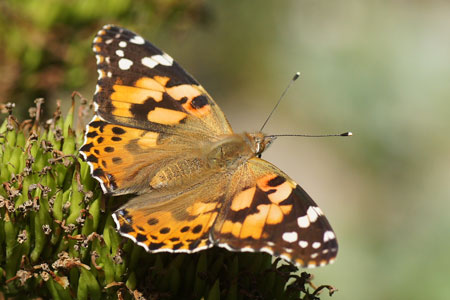 .. ..
 . .
 . .
 Painted
Lady, Thistle
butterfly, in North America:
the Cosmopolite (Vanessa cardui, syn. Cynthia cardui).
Family Nymphalidae.
Painted
Lady, Thistle
butterfly, in North America:
the Cosmopolite (Vanessa cardui, syn. Cynthia cardui).
Family Nymphalidae.
In 2007 and 2008 I saw oft painted ladies. Than I haven't seen them for several years. In 2012 I saw this butterfly again. It’s a migratory butterfly. It migrates from North Africa and the Mediterranean to Holland.
Adults
in northern Europe
migrate in
the autumn to North Africa and southern Europe.
When they stay they don’t survive the winter. Thistle Butterflies have orange wings with black spots. The tips of the wings are black with white spots. When the wings are folded, it is a nicely drawn butterfly.
The eggs are
laid on thistle, mallow or hollyhock leaves.
The butterfly on nectar plants, such as the buddleia. Not like the admiral on rotting fruit.
Wingspan 50 - 60 mm.
All over the world. Not in South America and Antartica. In Australia there
is a close relative, the Australian Painted Lady (Vanessa kershawi). Other closely related species are the American Painted Lady (Vanessa virginiensis) and the West Coast Lady (Vanessa
annabella). Photos
9-9-2012, 10-9-2012. German:
Distelfalter. French: Vanesse du chardon, vanesse
des chardons.
|
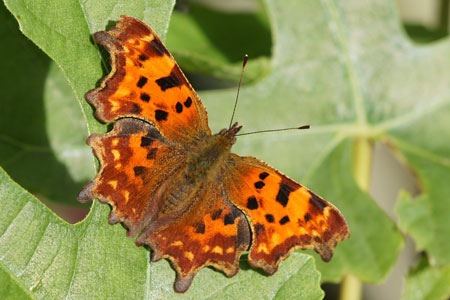 .. ..
 . .
 Comma (Polygonia c album).
Family Nymphalidae.
Comma (Polygonia c album).
Family Nymphalidae.
This butterfly hibernates in the Netherlands
Then it has the resemblance to a dead leaf.
They mate in March, April. Eggs are laid singly on the sprouting leaves of
the foodplant, usually nettle. The caterpillar can
easily be mistaken for a bird dropping.
In June there is a second generation, which
hibernates. The first generation is lighter than the second generation.
The
butterfly gets its name from the C or comma-shaped silver mark on the
underside of the hind wings. The wings are angular for a good camouflage.
Europe, North Africa and North and Central Asia. Photos 1-9-2010, 2-10-2010.
G
erman: C-Falter. French: Robert-le-Diable.

 9-5-2014, 18-5-2014. A young and an older caterpillar. Nettle, but also other plants, such as here on a
Jostaberry.
9-5-2014, 18-5-2014. A young and an older caterpillar. Nettle, but also other plants, such as here on a
Jostaberry.
|
 .. ..
 . .
 . .
 Atlanta,
Red Admiral
(Vanessa atalanta).
Family Nymphalidae.
Atlanta,
Red Admiral
(Vanessa atalanta).
Family Nymphalidae.
It is a migratory butterfly
found in temperate Europe, Asia and North America.
The species is
resident only in warmer areas, but migrates north in spring, and sometimes
again in autumn.
In April the first butterflies arrive in Holland.
They lay eggs in May June. In July the next generation flies in our garden.
It loves also rot fruit I ‘ve seen the titmouses peck holes in the plums.
Afterwards the Atalantas appear. When I am eating a plum, sometimes an
atalanta sits on my hand.
Red admiral caterpillars eat plants of the
nettle family
This is my
favourite butterfly. Also because it is not shy at all.
Wingspan 50 - 60 mm. Europe, Asia, North America.
German: Admiral. French: Vulcain.
I ‘ve taken more
photo’s long ago.. You can see them on an other page.
 Click here to see more
atalantas. Click here to see more
atalantas.
|
 ... ... Heliconius melpomene. Exotic!!
Family Nymphalidae.
Heliconius melpomene. Exotic!!
Family Nymphalidae.
I saw this butterfly in our garden. It's a Heliconius. Probably an older Heliconius melpomene. I had to get my camera first. I could take a few pictures from far away before it disappeared. The butterfly belongs in Central and South America. The Netherlands is far too cold in winter.
The caterpillars feed on
passion flowers.
Photos 15-7-2017.
|
Subfamily Satyridae
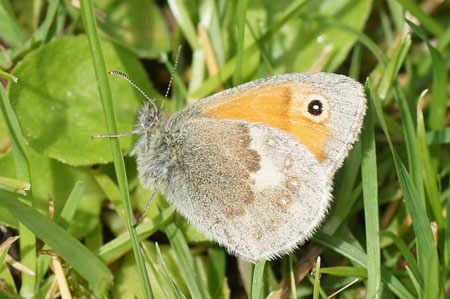 .. ..
 Small heath (Coenonympha pamphilus).
Subfamily Satyridae. Family Nymphalidae.
Small heath (Coenonympha pamphilus).
Subfamily Satyridae. Family Nymphalidae.
The wings are pale orange with a brown edge. At the top of the front wing is a brown eye. At the
underside is the eyespot surrounded by yellow. The underside of the hind wing is
largely grey.
The eggs are laid in the grass. They are placed separately at the base of a
grass blade. The caterpillars feed on different species of grasses.
April - September. Two generations.
It hibernates as a half-grown caterpillar.
Wingspan: 23 to 33 mm.
Eurasia, North Africa.
Photos 2-7-2012. German: Kleine Wiesenvögelchen. French: Fadet commun ou Procris.
|
 .. ..
 Grayling (Hipparchia semele).
Subfamily Satyridae. Family Nymphalidae. Not in the garden
but in the dunes 4 km from our house.
Grayling (Hipparchia semele).
Subfamily Satyridae. Family Nymphalidae. Not in the garden
but in the dunes 4 km from our house.
A large butterfly of the subfamily Satyridae. The underside of the forewing is orange with two eyespots. The
underside of the rear wing is drawn gray-brown. The upper side is dark brown with a yellow-brown markings. You
can find it in dry areas such as dunes and heathland. In recent years, the number
Graylings declined in the Netherlands. Wingspan 51 to 62 mm.
Caterpillar host plants: grasses like fescue (Festuca).
July - September. One generation. It hibernates as a half-grown caterpillar.
Europe.
Photos 20-7-2012. German: Ockerbindige Samtfalter, Rostbinde. French:
L'Agreste.
 11-8-2014. For the first time in our garden!!!
11-8-2014. For the first time in our garden!!!
|
 .. ..
 Wall brown (Lasiommata megera). Subfamily
Satyridae. Family Nymphalidae.
Wall brown (Lasiommata megera). Subfamily
Satyridae. Family Nymphalidae.
For the first time in the garden. It flew in the scullery. I've taken a few photos before it was allowed to leave our house. The small photo is of the underside.
Orange-brown wings with dark brown cross bands. On the forewing an eyespot. Also on the underside of the hindwing is a row of eyespots.
The caterpillars feed on different grasses.
April - September Two generations. Sometimes a third generation until November. Like this butterfly.
It overwinters as a half-grown caterpillar.
Wingspan: 40 to 52 mm.
Palearctic. The species has declined in the Netherlands.
Photos 9-10-2014. German: Mauerfuchs. French:
French: La Mégère, le Satyre.
 Only in 2020 did I see it in our garden again. Here with closed wings. Photo 7-26-2020.
Only in 2020 did I see it in our garden again. Here with closed wings. Photo 7-26-2020.
|
 .. ..
 . .
 . .
  Meadow
Brown (Maniola
jurtina). Subfamily Satyridae. Family Nymphalidae.
Meadow
Brown (Maniola
jurtina). Subfamily Satyridae. Family Nymphalidae.
The colour of the
female is more beautiful. The female is larger, has also a larger eye-spot
on each forewing and has an orange colouration on the forewings. Linnaeus even
thought, they were several species. Generally the male
butterfly is most beautiful.
The Meadow Brown occurs in a wide variety of grassland habitats such as
roadsides and gardens. The Meadow Brown will also fly in dull weather
The butterfly on the large photo is a male. The butterflies on the
last three photos are
females.
Flight
Time: May – August. But the adult lives less than a month.
Last two photos: 4-7-2010.
German: Große Ochsenauge.
French: Myrtil.
|
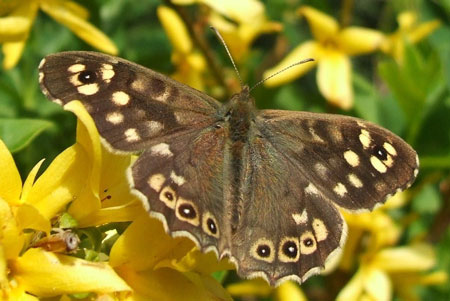 .. ..
 . .
 . .
 Speckled Wood (Pararge aegeria).
Subfamily Satyridae. Family Nymphalidae.
Speckled Wood (Pararge aegeria).
Subfamily Satyridae. Family Nymphalidae.
This is the subspecies: Pararge aegeria tircis. A brown butterfly with pale yellow spots.
The other subspecies is: Pararge aegeria aegeria. This species has orange spots and
occurs in Southern Europe. It can be found on my page about
insects in
France.
On the forewing is a dark eye-spot. At the rear wing are three or four dark eye-spots with a central white spot.
The wingspan is 32 to 42 mm.
The eggs are laid in the grass. (half in the shade) The caterpillars feed
on various species of grass.
Flight
Time: March - October. Two, three generations.
It overwinters as a caterpillar or as a pupa. German: Waldbrettspiel. French:
Tircis.
 Male and female 6-5-2014.
Male and female 6-5-2014.
|
Pieridae
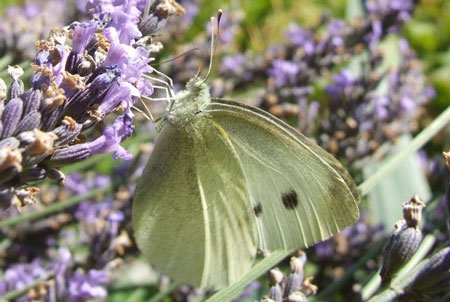 .. ..
 . .
 . .
 Small
White (Pieris
rapae). Family
Pieridae.
Small
White (Pieris
rapae). Family
Pieridae.
In Holland, there
are generally 3 generations each year. Small White is creamy white with black tips to the forewings. Females also
have two black spots in the center of the forewings.
Its caterpillars can be a pest on cultivated cabbages, but it will readily
lay eggs on wild members of the cabbage, as Garlic mustard .
It hibernates as a
pupa.
Wingspan 40 - 50 mm.
It is difficult to take photos, because they are very restless.
It is
widespread across Europe, North Africa and Asia and has also been
accidentally introduced to North America, Australia and New Zealand.
German: Kleine Kohlweißling.
French: Piéride de la rave, Petit Blanc du chou.
|
 .. ..
 . .
 . .
 Large
White or Cabbage
White (Pieris brassicae).
Family Pieridae.
Large
White or Cabbage
White (Pieris brassicae).
Family Pieridae.
White wings with black
tips on the forewings. Generally more vertical than horizontal (difference with
the Small White) The
female also has two black spots on each forewing.
. Its caterpillars
also feed on cultivated cabbages and members of the cabbage.
Wingspan 60 - 70 mm.
It hibernates as a pupa. They are flying from March to October.
The
Large White is common throughout Europe, North Africa and Asia to the
Himalayas.
German: Große Kohlweißling.
French: Piéride du chou.

 The caterpillars of a large white eating Annual
Honesty or Silver
Dollar
(Lunaria annua). From caterpillar to butterfly: forum.waarneming.nl/smf/index.php?topic=430451.0
The caterpillars of a large white eating Annual
Honesty or Silver
Dollar
(Lunaria annua). From caterpillar to butterfly: forum.waarneming.nl/smf/index.php?topic=430451.0 |
 .. ..
 . .
 . .
 Green-veined
White (Pieris
napi). Family
Pieridae.
Green-veined
White (Pieris
napi). Family
Pieridae.
It rarely lays its eggs
on garden cabbages, for it prefers wild crucifers, as Garlic
mustard and Hedge mustard. It is often mistaken
with the Large and Small Whites. Especially when it is flying. But
the Green-veined White has grey greenish dusky vein markings on the
undersides of the wings.
The female has two spots on each forewing, the male only one. (Not visible
at all my photos)
It hibernates as a
pupa.
Wingspan
40 - 50 mm. March - October.
Widespread across
Europe,
Asia including the Indian subcontinent and North America.
German: Rapsweißling.
|
 . .
 . .
 . .
 . .
 Green-veined
White (Pieris
napi). Family
Pieridae.
From caterpillar to butterfly.
Green-veined
White (Pieris
napi). Family
Pieridae.
From caterpillar to butterfly.
13-6-2019 I saw a caterpillar of the green-veined white on garlic mustard. 17-6 it changed into a puppa. 19-6 I took another photo of the pupa. 29-6 the butterfly appeared and an empty pupa remained.
|
 Dark Clouded Yellow, Common Clouded Yellow(Colias
croceus). Family Pieridae. Not in the garden
but in the dunes 4 km from our house.
Dark Clouded Yellow, Common Clouded Yellow(Colias
croceus). Family Pieridae. Not in the garden
but in the dunes 4 km from our house.
The only photo. After that it flew away. Because of the bright sun, it is not a
beautiful picture, but I have no other.
It looks like the Pale Clouded Yellow (Colias hyale) and Berger's Clouded Yellow
(Colias alfacariensis). The dark band at the upper side of the wings isn't
visible in this picture. When it flies it is distinguished by the orange
colour. With this photo the other species are also possible but I have
seen this common clouded yellow flying,.
The first generation is from Southern Europe and North Africa.
May - October. Two generations.
The caterpillar feeds on legumes, including alfalfa and vetch.
Wingspan about 40-50 mm.
Europe, North Africa and Asia. Photo 10-10-2014.
|
 male
male 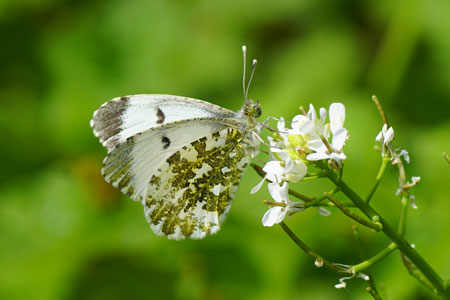 female
female
Orange tip (Anthocharis cardamines). Family Pieridae.
A spring butterfly.
White wings with a grey to grey-black tip and with a black dot in the middle. Only in the male is the tip of the front wings striking orange. The underside of the forewings is marbled yellow-green.
The caterpillars are approximately 30 millimeters long. Pale bluish green with a white lateral line, below which the colour changes to dark green.
Mid April - end of May. One generation.
The caterpillar feeds on cuckooflower, garlic mustard and sometimes other crucifers and feeds mainly on the seed pods. It pupates and attach themselves with a silken girdle to a nearby woody stem and hibernates in this way.
Wingspan 35-45 mm.
Europe, Middle East and Asia. Photos 6-4-2020, 10-5-2020.
|
Orange tip (Anthocharis
cardamines). Family Pieridae. From
caterpillar to butterfly!!!
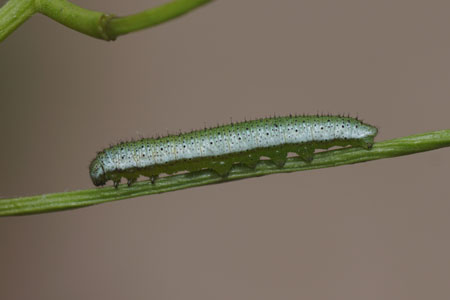 .. ..
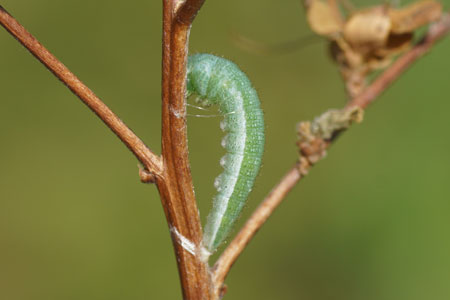
27-5-2019 and 2-6-2019
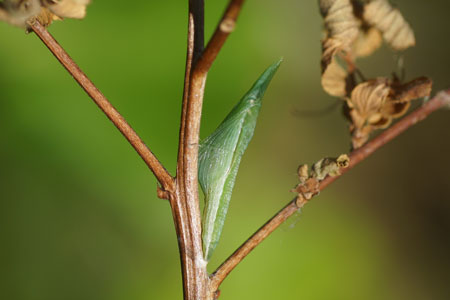 .. ..

2-6-2019 and 13-6-2019
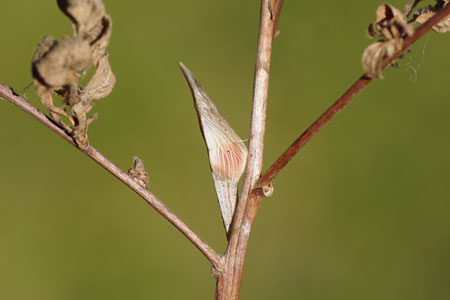 .. ..
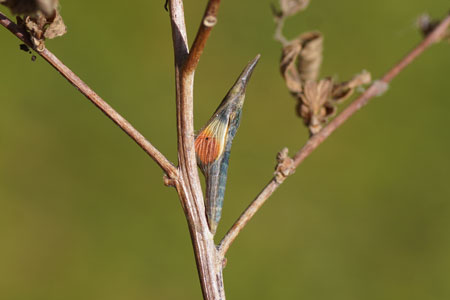
1-4-2020 and 7-4-2020
 .. ..
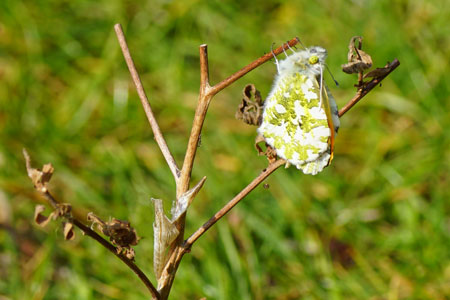
8-4-2020
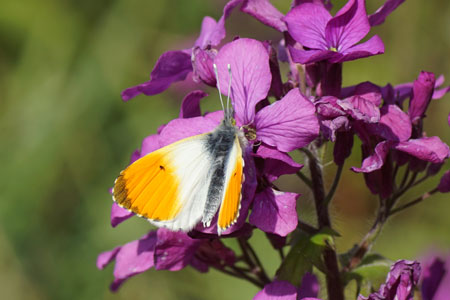 .. ..

8-4-2020
|
Blues (Lycaenids)
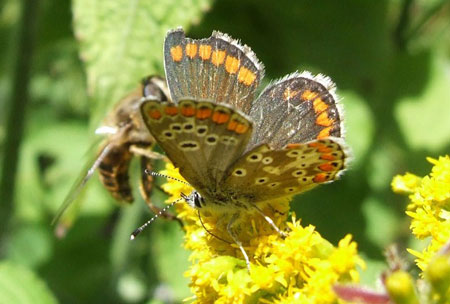 .. ..
 . .
 . .
 Brown Argus (Aricia agestis, formely Plebeius agestis). Family Lycaenidae or Blues.
Brown Argus (Aricia agestis, formely Plebeius agestis). Family Lycaenidae or Blues.
The wings has a row of orange spots along the border.
You find them especially along the coast. But also along the rivers. Often
on sandy soil.
Foodplant: Especially geranium species. May - October. Two sometimes three generations.
The half-grown caterpillars hibernate. (in litter)
Central and Southern Europe. German: Kleine Sonnenröschen-Bläuling. French:
Collier-de-corail, argus brun.
|
 .. ..
 . .
 . .
 Holly
Blue (Celastrina argiolus). Family Lycaenids or Blues.
Holly
Blue (Celastrina argiolus). Family Lycaenids or Blues.
The bright green caterpillars feed mostly on holly spindles, and ivy. All three shrubs are in our garden. The Holly Blue flies oft high up around trees and bushes in full sunlight.
It ‘s a small, beautiful butterfly. At the
upper side of the forewings only the females have broad black borders. But
it’s difficult to see, for the adults don’t open their wings oft . They
only open their wings early
in the morning or late in the evening to warm up in the sunshine.
It hibernates as a
pupa. There
are two broods a year.G
erman: Faulbaum-Bläuling.
French: L'azuré des nerpruns.
|
 .. ..
 . .
 . .
 Small Copper, American Copper or Common
Copper (Lycaena phlaeas). Family Lycaenids or Blues.
Small Copper, American Copper or Common
Copper (Lycaena phlaeas). Family Lycaenids or Blues.
The Small Copper belongs to the Blues, although there is not much blue on
this butterfly.
Wingspan: about 25 mm.
April - October. Three generators.
Hosts: Sheep's sorrel (Rumex acetosella) , Common Sorrel or Garden Sorrel
(Rumex acetosa)
Caterpillar: August - May and May - July. It overwinters as a caterpillar.
The butterfly is found in the Palearctic
and the Nearctic. German: Kleine Feuerfalter. French: Lycaena
phlaeas.
|
 .. ..
 . .
 Common Blue (Polyommatus icarus).
Family Lycaenidae.
Common Blue (Polyommatus icarus).
Family Lycaenidae.
The drawing of the underside of the wings is very similar to that of the brown
argus. This common blue held its wings folded. It was the first time I saw one in the garden. The
upper side of the wings of the male is blue, of the female blue but also brown.
Wingspan 25-30 mm.
April to October. Two sometimes three generations. The caterpillar overwinters.
Host plants for caterpillars: Plants of the pea, or bean familyas many clover species.
Europe. Photos 16-8-2012, 14-8-2013. German: Hauhechel-Bläuling. French: us bleu ou Azuré commun ou Azuré de la
Bugrane.
 A beautiful blue Common Blue, 13-5-2014.
A beautiful blue Common Blue, 13-5-2014.
|
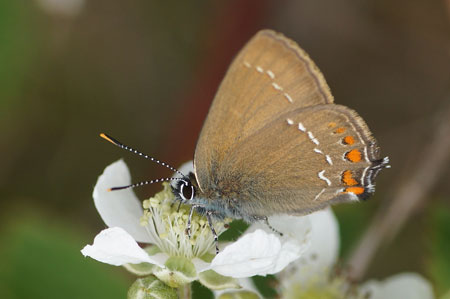 .. ..
 Ilex Hairstreak (Satyrium ilicis).
Family Lycaenidae. Not in the garden
but in the dunes 4 km from our house.
Ilex Hairstreak (Satyrium ilicis).
Family Lycaenidae. Not in the garden
but in the dunes 4 km from our house.
The upper side of the wings is dark brown. The underside of the wings is brown with a row of small white spots.
On the lower wings are above some orange spots, a white line and a tail.
In the Netherlands it's a fairly rare butterfly, which occurs mostly on sandy soil.
Similar species are the White-letter Hairstreak (Satyrium w-album) and the
Black Hairstreak (Satyrium pruni)
Wingspan 16-18 mm.
June - August One generation. It overwinters as an egg on a branch or trunk.
Host plants for caterpillars: Oak. Butterflies are often (as in this photo) on the flower burr.
Europe, Asia Minor.
Photos 24-6-2014. German: Braune Eichen-Zipfelfalter.
French: Thécla de l'yeuse. |
Hesperiidae.
Skippers are recognizable by the large head and short wings. They have the antennae clubs hooked backward. At rest the
forewings are folded together or held at 45o angle, while the rear wings remain
open and flat. Grasses are host plants of the caterpillars of the most skippers.
Not in the garden but in the dunes 4 km from my house. I've seen in our
garden, but I could not take photos at that moment.
 .. ..
 Large Skipper (Ochlodes sylvanus, synonym
Ochlodes faunus). Family skippers or skipper butterflies (Hesperiidae).
Large Skipper (Ochlodes sylvanus, synonym
Ochlodes faunus). Family skippers or skipper butterflies (Hesperiidae).The underside of the rear wing is yellowish brown with light spots. Host plants: Various species of grasses. Sandy and
peat grounds. Grasslands (no clay), forest clearings. Overwinters as half-grown caterpillar. June - August. Wingspan 25 - 32 mm. Europe.
Photos 15-7-2012, 17-6-2013.
|
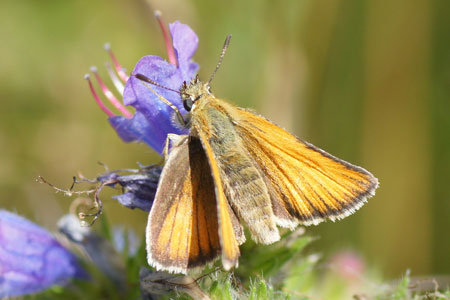 Essex Skipper (Thymelicus lineola).
Family skippers or skipper butterflies (Hesperiidae).
Essex Skipper (Thymelicus lineola).
Family skippers or skipper butterflies (Hesperiidae).
Lichtbruim to yellow, without drawing, at the upperside of the wings. The underside of
antennae club is black. (difference with Thymelicus sylvestris.) Flowery places with tall grasses.
Eggs on the stems of grasses where they remain over the winter. May - August. Wingspan 22 - 26 mm. Europe.
Introduced to North America in 1910. Photo 15-7-2012.
|
Nederlands /
Dutch
 
Subpage France:
Insects
France
Subpage butterflies
and moths:
Owlet
moths, noctuidae Geometer
moths Leafrollers,
tortrix moths Pyralidae,
Crambidae Concealer
moths, Oecophoridae
|
